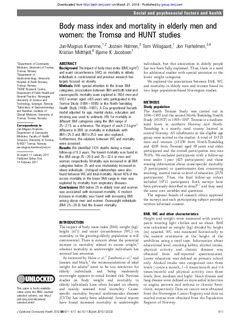| dc.contributor.author | Kvamme, Jan-Magnus | |
| dc.contributor.author | Holmen, Jostein | |
| dc.contributor.author | Wilsgaard, Tom | |
| dc.contributor.author | Florholmen, Jon | |
| dc.contributor.author | Midthjell, Kristian | |
| dc.contributor.author | Jacobsen, Bjarne K. | |
| dc.date.accessioned | 2018-03-21T10:17:32Z | |
| dc.date.available | 2018-03-21T10:17:32Z | |
| dc.date.issued | 2010 | |
| dc.identifier.citation | Kvamme J, Holmen J, Wilsgaard T, et al. (2010). Body mass index and mortality in elderly men and women: the Tromsø and HUNT studies. J Epidemiol Community Health, 2012;66:611-617. | nb_NO |
| dc.identifier.uri | http://hdl.handle.net/11250/2491434 | |
| dc.description.abstract | BACKGROUND: The impact of body mass index (BMI; kg/m(2)) and waist circumference (WC) on mortality in elderly individuals is controversial and previous research has largely focused on obesity.
METHODS: With special attention to the lower BMI categories, associations between BMI and both total and cause-specific mortality were explored in 7604 men and 9107 women aged ≥ 65 years who participated in the Tromsø Study (1994-1995) or the North-Trøndelag Health Study (1995-1997). A Cox proportional hazards model adjusted for age, marital status, education and smoking was used to estimate HRs for mortality in different BMI categories using the BMI range of 25-27.5 as a reference. The impact of each 2.5 kg/m(2) difference in BMI on mortality in individuals with BMI < 25.0 and BMI ≥ 25.0 was also explored. Furthermore, the relations between WC and mortality were assessed.
RESULTS: We identified 7474 deaths during a mean follow-up of 9.3 years. The lowest mortality was found in the BMI range 25-29.9 and 25-32.4 in men and women, respectively. Mortality was increased in all BMI categories below 25 and was moderately increased in obese individuals. U-shaped relationships were also found between WC and total mortality. About 40% of the excess mortality in the lower BMI range in men was explained by mortality from respiratory diseases.
CONCLUSIONS: BMI below 25 in elderly men and women was associated with increased mortality. A modest increase in mortality was found with increasing BMI among obese men and women. Overweight individuals (BMI 25-29.9) had the lowest mortality. | nb_NO |
| dc.publisher | Journal of Epidemiology and Community Health | nb_NO |
| dc.rights | Navngivelse-Ikkekommersiell 4.0 Internasjonal | * |
| dc.rights.uri | http://creativecommons.org/licenses/by-nc/4.0/deed.no | * |
| dc.subject | body mass index | nb_NO |
| dc.subject | BMI | nb_NO |
| dc.subject | mortality | nb_NO |
| dc.subject | elderly | nb_NO |
| dc.subject | pasientsikkerhet | nb_NO |
| dc.subject | ernæring | nb_NO |
| dc.title | Body mass index and mortality in elderly men and women: the Tromsø and HUNT studies | nb_NO |
| dc.type | Journal article | nb_NO |
| dc.source.pagenumber | 611-617 | nb_NO |
| dc.source.volume | 2012 | nb_NO |
| dc.source.journal | Journal of Epidemiology and Community Health | nb_NO |
| dc.source.issue | 66 | nb_NO |
| dc.identifier.doi | http://dx.doi.org/10.1136/jech.2010.123232 | |

